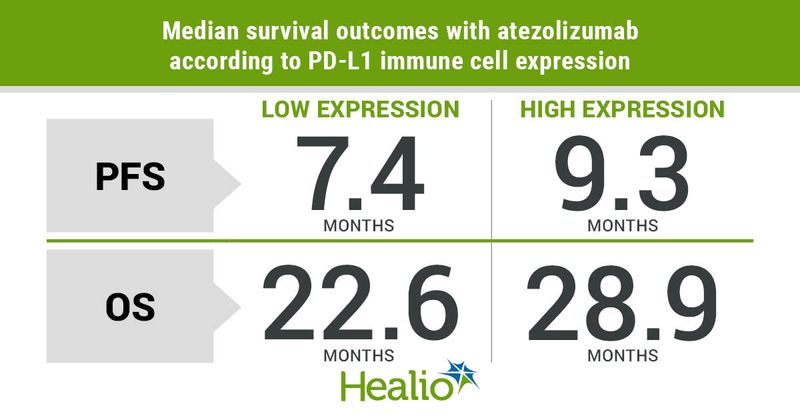Benefit of atezolizumab regimen may be limited to triple-negative breast cancer subset
The benefit of atezolizumab plus nab-paclitaxel in advanced triple-negative breast cancer appeared limited to patients with PD-L1 immune cell-positive tumors, an exploratory analysis of the IMpassion130 trial showed.
Other immune biomarkers, such as PD-L1 tumor cell expression, CD8+ T-cell count and stromal tumor-infiltrating lymphocyte positivity, as well as BRCA mutation status, may not further help to identify patients who could benefit from the combination, according to the analysis, published in Journal of the National Cancer Institute.

“The IMpassion130 trial demonstrated clinically meaningful PFS and OS benefit for patients with metastatic PD-L1 immune cell-positive triple-negative breast cancer treated with the combination of atezolizumab [Tecentriq, Genentech/Roche] and nab-paclitaxel [Abraxane, Celgene],” Leisha A. Emens, MD, PhD, professor of medicine and co-leader of the immunology and immunotherapy program at UPMC Hillman Cancer Center and director of translational immunotherapy for the Women’s Cancer Research Center at Magee Women’s Hospital in Pittsburgh, told Healio.
The double-blind, multicenter IMpassion130 study included 902 patients with metastatic or unresectable locally advanced triple-negative breast cancer.
Researchers randomly assigned patients to first-line treatment with 100 mg/m2 nab-paclitaxel on days 1, 8 and 15 of a 28-day cycle plus either 840 mg atezolizumab every 2 weeks (n = 451) or placebo (n = 451).
Results showed nab-paclitaxel plus atezolizumab, an anti-PD-L1 agent, improved PFS and OS compared with nab-paclitaxel plus placebo among patients with PD-L1 immune cell-positive tumors.

“Other immune biomarkers, including CD8+ T cells, stromal tumor infiltrating lymphocytes and PD-L1 expression on tumor cells, have been associated with clinical benefit from PD-1/PD-L1 inhibition,” Emens said. “In addition, the DNA damage associated with BRCA mutations may result in greater responsiveness to immune checkpoint blockade.”
Emens and colleagues sought to determine whether these other biomarkers and BRCA mutation status also could be used to identify patients most likely to benefit from the atezolizumab regimen.
Median follow-up in the biomarker-defined patient subgroups was 18 months.
Results showed PD-L1 immune cell expression in either primary or metastatic tumor tissue appeared associated with a PFS and OS benefit. Researchers observed similar improvement in outcomes among those with both low (26.9%) and high (13.9%) expression.
Researchers reported HRs for PFS with the atezolizumab vs. placebo regimen of 0.61 (95% CI, 0.46-0.8) among those with low expression and 0.71 (95% CI, 0.48-1.05) among those with high expression, and HRs for OS of 0.68 (95% CI, 0.48-0.94) and 0.76 (95% CI; 0.46-1.26).
In the atezolizumab group, those with low PD-L1 immune cell expression had slightly shorter median PFS (7.4 months vs. 9.3 months) and median OS (22.6 months vs. 28.9 months) than those with high expression.
Improvements in outcomes were observed with the atezolizumab regimen whenever PD-L1 immune cell expression was 1% or greater, according to the researchers.
Although intratumoral CD8 and stromal tumor infiltrating lymphocyte positivity correlated with PD-L1 immune cell expression, the PFS and OS benefit with atezolizumab occurred only among those who also had PD-L1 immune cell expression, and regardless of BRCA status.
“Although atezolizumab [plus] nab-paclitaxel was more efficacious in patients with a richer tumor immune microenvironment, clinical benefit was only observed in patients with triple-negative breast cancer whose tumors were PD-L1 immune cell-positive,” Emens said. “We are also conducting exploratory studies to determine whether distinct genomic features or immune phenotypes of patient tumors are associated with clinical benefit from atezolizumab and nab-paclitaxel in IMpassion130.”
It remains unclear whether tumor-infiltrating lymphocytes or CD8+ T cells add predictive value to PD-L1 levels, according to an editorial accompanying the study by Bora Lim, MD, associate professor of oncology/medicine at Baylor College of Medicine.
“Improving patient outcomes is the goal of biomarker research,” Lim wrote. “In this context, the toxicities of immune checkpoint inhibitors should not be overlooked, particularly when immune checkpoint inhibitor is incorporated in curable patients, such as those receiving neoadjuvant therapies. When patients walk in the clinic with documented PD-L1 expression levels measured by commercially available multi-omics profiling, we should consider the complexities of PD-L1 positivity measurement and other associated biomarkers that can influence our treatment decisions.”
References:
Emens LA, et al. J Natl Cancer Inst. 2021;doi:10.1093/jnci/djab004.
Lim B. J Natl Cancer Inst. 2021; doi:10.1093/jnci/djab005.
For more information:
Leisha A. Emens, MD, PhD, can be reached at UPMC Hillman Cancer Center/Magee Women’s Hospital, 5117 Centre Ave., Pittsburgh, PA 15213; email: emensla@upmc.edu.

